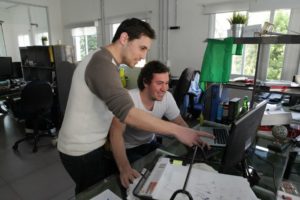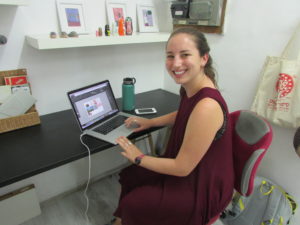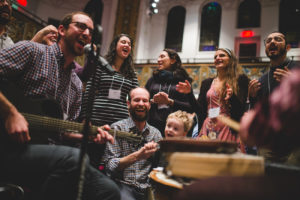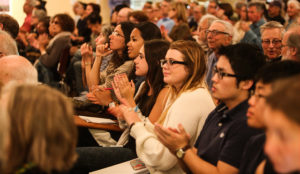The message will resonate with members of his New Synagogue Project, which is one of an increasing number of U.S. Jewish organizations that are challenging the modern American image of Jews as Jerry Seinfeld-ian (or Sarah Silverman-ish) and bringing much more visibility and voice to Jews whose roots are African American, Middle Eastern, Asian and everything in between. The trend has opened conversations on racism, equity of power in the Jewish community, conversion and what it means to be “really Jewish.”
“There’s this problematic narrative, that Jews of color are new to the community because they’re converts or part of mixed marriages, and that’s not true,” Berman said. “For some Jews of color, that’s part of their story, but there have always been Jews of color. It’s where Judaism started.”
Groups and projects have been popping up increasingly around the country in the last couple years. Community leaders say the rising national conversation about racism has prompted a more intense confronting of how it plays out among white Jews. Jews of color in 2019 are also more comfortable challenging racism and institutional underrepresentation.
There are new synagogues like Berman’s, which began last year in Petworth; new affinity groups within synagogues for Jews of color like the Kehilah Multiracial Engagement Project at the large Conservative synagogue Adas Israel; and new national groups like the California-based Jews of Color Field Building Initiative, which gives grants to efforts that are “intentionally developing/nurturing environments in which multiracial Jewish community can thrive,” according to its website. Their first year, they gave out $200,000.
Sunday night begins Rosh Hashanah, the start of the Jewish calendar and an intense 10-day sacred period called the High Holy Days, or “Yamim Noraim,” or Days of Awe. The period, which ends with Yom Kippur on Oct. 9, calls Jews to self-reflect, to turn to God, to repent, soul-search, forgive, move on with gratitude. It’s among the most observed rituals for U.S. Jews, and the most likely time for them to come to synagogue (about 40 percent of Jews almost never, or never, go to synagogue, according to Pew Research. Another 35 percent attend sporadically for the High Holidays or other services).
The increased institutional attention to Jews of color during this time is taking different forms. For some, it’s meant weaving personal and societal confessions for racism into the Yom Kippur confessional prayer, called Ashamnu, adding mass incarceration, police violence and racially unequal access to housing. With a spike in reported anti-Semitic hate crimes, U.S. Jewish institutions have been pouring more money into security, which often means uniformed police and visible firearms. Leaders of several institutions said they were thinking hard this year, with bigger crowds, at what security should look like in a diverse community.
A phalanx of police conducting security checks “is definitely a turnoff for folks of color,” said Emma Rafaelof, 24, an international affairs policy analyst who is ethnically Chinese and was adopted by a Mom who is Ashkenazi (or Eastern European) and a father from Iran. She grew up in Colorado. “Some may not want to come to services because they don’t want to get into a situation where they’re facing law enforcement.”
Rafaelof is a team leader of the Jews of color group at Berman’s Project. The group is called POCISM — People of Color, Indigenous people and Sephardi and Mizrahi Jews, the latter two terms referencing Jews with roots in the East, North Africa, or Spanish-speaking places. The group is keeping these issues in mind as they plan security this year.
Estimates of the number of Jews of color vary. A Washington Post analysis of General Social Survey Data found that in this decade, 89 percent of U.S. Jews are white, down from 99 percent in the 1970s. The reason for the increase in Jews of color isn’t clear, but it’s happening as the country overall is diversifying. About one-third of married Jews have a spouse who is not Jewish, Pew Research found.
While Jews in the United States have for centuries been considered legally “white,” they weren’t until recent decades considered culturally part of the social mainstream — living largely in enclave and banned in some places from getting jobs, spots in universities, slots at clubs or houses in certain neighborhoods. Jews have a hugely wide range of views about what makes someone “Jewish” — whether it’s culture, theology, practice, birth, or a mix. Because of immigration peaks in the last century or so, many American Jews have roots in Eastern Europe, and are ethnically Ashkenazi.
The new movement to look at what some call “Ashke-normification” challenges assumptions about what it means to look like and be Jewish.
There was never one answer in Judaism, and it’s only getting more complex.
Under Jewish law, Jewish status is defined by whether one’s birth mother is Jewish. Much of institutional U.S. Judaism has broadened, including people as Jews if their fathers are Jewish or if they’ve converted in a process recognized by one’s community. This is not a small issue in more orthodox communities, and in Israel, where state rabbis in recent years have been tightening the restrictions on which conversions they will accept.
From an official point of view, one cannot simply state that they accept Judaism and be recognized formally as a Jew, even in the more progressive parts of institutional Judaism. At the same time, much of institutional U.S. Judaism has been rapidly opening up to interfaith families and the inclusion of people exploring Judaism but who have not converted.
So the question of one’s heritage isn’t trivial in Judaism. However, to see these questions of legitimacy raised in otherwise liberal Jewish communities, where standards are fluid on everything from keeping the Sabbath to belief in God, to some smacks of simple racism.
Jews of color interviewed for this piece described entering Jewish spaces and being asked, essentially: Why are you here? Even if it’s well-intentioned, Jews of color say, being asked if you’re married to a Jewish person or converted is part of an “othering” that can push people out.
“How can Jews of color be totally engaged if they’re profiled on their way to synagogue?” said Ilana Kaufman, executive director of the Field Building Initiative. “Jews of color are asked: Who do they know here? What’s the rabbi’s name? Someone using the facilities might be asked if they’re janitorial staff.” She said she believes there is some American Jewish anxiety around the topic of nonwhite Jews that’s not unlike American anxiety and racism about national demographic shifts.
“They worry about diluting Jewishness, that people of color celebrating their Jewish identity will eclipse our ‘Jewishness.’ It’s like we’re dealing with a finite pie,” she said.
New efforts are focusing on racial sensitivity training for clergy and community leaders, leadership pathways for people of color and the inclusion of Jewish role models of color.
Carla Mays, 39, a San Francisco planner and research analyst, is a board member of the Jewish Multiracial Network. Founded in the 1990s by parents working to support multiracial Jewish families, the Network is one of the older groups working on advocating for Jews of color.
Mays says she has limited patience with conversations that are limited to sensitizing language. She wants to see Jews of color have a fair crack at grants and leadership positions.
“We want inclusion, not to talk about difference,” she said this week. Mays, who is African American, traces her Jewish roots to her great-grandmother, who considered Judaism part of her religious identity. Growing up in Los Angeles, she saw how her mother and grandmother considered Judaism a core part of who they were and their heritage, but did not feel welcome in institutional Jewish life. Mays said she felt torn once she moved to San Francisco as she tried to balance between Jewish and African American spaces.
“I couldn’t worship in peace, and was constantly questioned about who I was. And I saw [young Jews of color] having to bear that brunt. . . . That’s why I stepped into this role,” she said of her work in the Network.
Andrew Esensten has been studying and writing about Jews of color in the U.S. and Israel for a decade. He calls today “the most exciting time since then, because race and how it plays out in the Jewish community is finally being taken seriously.” He studies everyone from Andy Cheng, a Chinese American convert who just became president of a major Palo Alto synagogue, to the Hebrew Israelites, a diverse group of people of color who believe they, not white people, are descendants of ancient Israel.
Right now, he says, the focus of these new efforts is simple: Raising awareness about the diversity of Jewish people that has always been there.
“That’s surprisingly harder than it might seem.”
Source: “During the Jewish High Holidays, there’s a growing awareness that not all U.S. Jews are white,” September 28, 2019, Washington Post
 Israel’s vibrant economy, thriving technology and innovation sectors, and multi-cultural landscape make it an ideal place for college-age students looking to have a resume-enhancing experience that builds life-skills and can help them when they enter the workforce. Because they are immersed in the Israeli workplace and society—they are placed in housing and have opportunities to tour the country—participants return home with greater knowledge, sense of connection, and engagement in Jewish life and Israel. Evaluations of participants before and after the program show that they increase their knowledge about diversity and variety in Israeli life, society, and politics; their sense of responsibility and connection to Israelis and the Jewish people; the ability to explain to others why being Jewish and engaging with Israel are important; and knowledge of Judaism, Jewish communities, and the diversity of approaches to Judaism.
Israel’s vibrant economy, thriving technology and innovation sectors, and multi-cultural landscape make it an ideal place for college-age students looking to have a resume-enhancing experience that builds life-skills and can help them when they enter the workforce. Because they are immersed in the Israeli workplace and society—they are placed in housing and have opportunities to tour the country—participants return home with greater knowledge, sense of connection, and engagement in Jewish life and Israel. Evaluations of participants before and after the program show that they increase their knowledge about diversity and variety in Israeli life, society, and politics; their sense of responsibility and connection to Israelis and the Jewish people; the ability to explain to others why being Jewish and engaging with Israel are important; and knowledge of Judaism, Jewish communities, and the diversity of approaches to Judaism.
 people with varying levels of knowledge, passions, and visions for future Jewish life. Hadar’s
people with varying levels of knowledge, passions, and visions for future Jewish life. Hadar’s  Hadar’s timely resources include a new
Hadar’s timely resources include a new  In recent years, the Institute hosted the annual meeting of the Association for Israel Studies, brought Israeli Supreme Court Justice Daphne Barak-Erez as The Rosalinde and Arthur Gilbert Foundation Scholar-in-Residence, sponsored courses ranging from Israeli Constitutional Law to Religion in Israel, and hosted up to five stellar visiting professors per year to teach and mentor in their areas of expertise.
In recent years, the Institute hosted the annual meeting of the Association for Israel Studies, brought Israeli Supreme Court Justice Daphne Barak-Erez as The Rosalinde and Arthur Gilbert Foundation Scholar-in-Residence, sponsored courses ranging from Israeli Constitutional Law to Religion in Israel, and hosted up to five stellar visiting professors per year to teach and mentor in their areas of expertise.